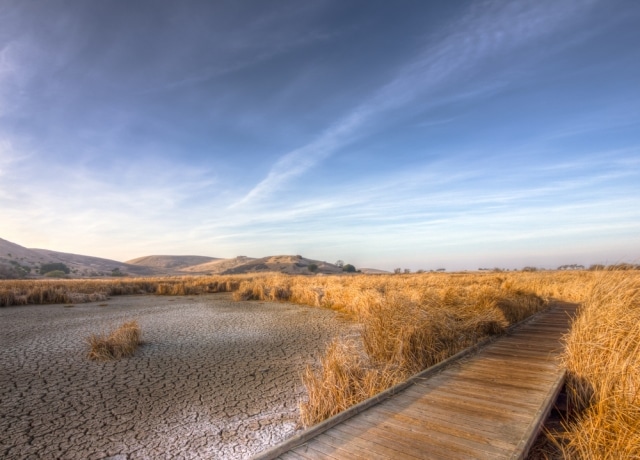As of January 26, the California Department of Water Resources reported that snowpack statewide was at just 27% of its normal level, which is 15% of the average for April 1, the point at which snow is typically expected to stop accumulating and begin to melt.
Which means, of course, that California is in for another dry year. Melting snowpack provides water to streams and rivers and replenishes reservoirs that are used for drinking water and agriculture.
In a cruel irony, a dry year also means more fossil fuels will have to be burned for electricity to make up for the shortfall in hydropower generation. And burning more fossil fuels will, of course, pump even more greenhouse gases into our atmosphere, making global warming worse.
In addition to being the hottest year on record in California, 2014 was also the third year of extreme drought in the state, which scientists tell us is a telltale sign that global warming is already impacting our lives right here and right now.
But last month, the National Oceanic and Atmospheric Administration released a report that concluded “natural oceanic and atmospheric patterns are the primary drivers behind California’s ongoing drought,” not climate change. Climate deniers pounced on the news, and many media outlets proclaimed, as did USA Today, “Causes of Calif. drought natural, not man-made.”
A trio of scientists gathered at the office of Climate Nexus in San Francisco later that month to hold a press conference that was in part focused on discussing the NOAA report and how it in no way contradicts the mountains of evidence showing that climate change is indeed, at the very least, making California’s drought much worse.
As Forbes reported, the scientists said that the perception that the NOAA study disproved a connection between the California drought and climate change “derives from NOAA’s focus on only one aspect of the drought—mean rainfall. When you look at the drought as an extreme event, [the scientists] said, and when you look at its probability of recurring, and when you look at not only rainfall but also temperature and evaporation, there’s no doubt what’s behind the drought.”
“One of the things that is certainly making it worse is climate change,” said Jonathan Overpeck, a co-director of the Institute of the Environment at the University of Arizona.
Noah Diffenbaugh, an associate professor in the School of Earth Sciences at Stanford University and a senior fellow at the Stanford Woods Institute for the Environment who was also present at the Climate Nexus press conference, sees no conflict whatsoever between his findings that there is a link between the drought and climate change and the results of the NOAA study.
“Our research finds that extreme atmospheric high pressure in this region — which is strongly linked to unusually low precipitation in California — is much more likely to occur today than prior to the human emission of greenhouse gases that began during the Industrial Revolution in the 1800s,” Diffenbaugh said when the results of his study were published last September in the Bulletin of the American Meteorological Society.
“If you look at [the NOAA] report, their statements that precipitation deficits in California during the current drought can be explained by sea surface temperature anomalies, that’s not inconsistent with what we reported in our paper,” Diffenbaugh tells DeSmogBlog. “There’s no conflict in those results. We’re focused on extremes, so statements about mean seasonal precipitation in the scenarios of future increasing greenhouse gas concentrations don’t invalidate findings about probability of persistently high atmospheric pressures over the Northeast Pacific in the current climate versus the pre-Industrial climate.”
When you look at all of the potential signals of climate change, Diffenbaugh says, you get the complete picture — a picture with climate change very much in the foreground. Which brings us back to California’s dismal snowpack numbers.
“One of the clearest signals of climate change that we have in North America is snowpack, and we understand the physics of that pretty well,” Diffenbaugh says. “We’re already seeing in much of Western North America earlier melting of snow, and the change in the hydrology of areas dominated by snow is one of the conclusive pieces of evidence of regional climate change. The hydrology of Western North America is changing, and those changes are consistent with anthropogenic climate change and not consistent with natural variability.”
While parts of California did receive heavy rainfall in December 2014, there is no end in sight to the drought. Aside from the fact that there was not nearly enough precipitation to return snowpack to its normal level, there’s this: NASA reports that the state would need 11 trillion gallons of water to fully recover from the three years of drought it has experienced.
By December 16, California had recorded about 94 billion gallons of rainfall, which sounds like a lot until you realize that’s less than 1% of what NASA says is needed.
The Pacific Institute’s Dr. Peter Gleick sums it up succinctly enough in a recent blog post: “The State of the California Drought: Still Very Bad.”
Image Credit: nvelichko / Shutterstock.com
Subscribe to our newsletter
Stay up to date with DeSmog news and alerts






